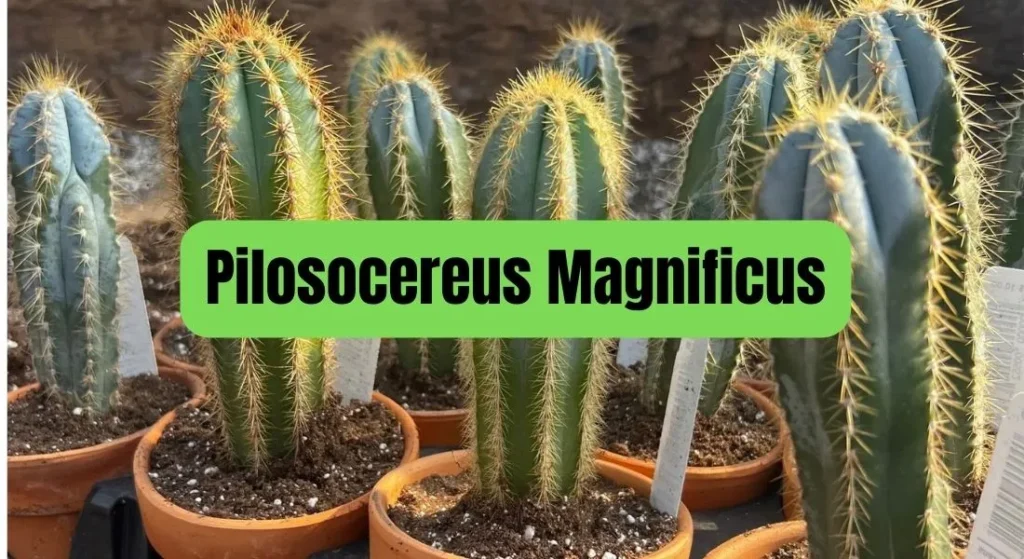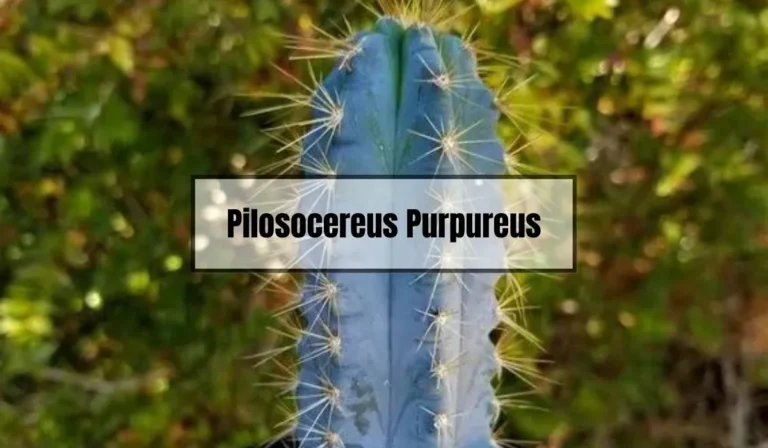Unleash Beauty: Why Pilosocereus Magnificus is a Must-Have Cactus
Are you a plant lover looking for a stunning addition to your collection? Consider Pilosocereus magnificus, a slow-growing cactus native to Brazil. Its cylindrical stems, dense white spines, and pink or white flowers make it a breathtaking addition to any collection.
It’s not only beautiful but also incredibly low-maintenance. Whether you’re an experienced collector or just starting out, Pilosocereus magnificus is a must-have for any plant lover.

What is Pilosocereus Magnificus?
If you’re a cactus enthusiast, then you know that Pilosocereus magnificus is a unique and beautiful species of cactus that is native to Brazil. This cactus is part of the Cactaceae family and is commonly referred to as the “hairy cactus” due to the hair-like spines that cover its body.
Pilosocereus magnificus is a tall and slender cactus that can grow up to 15 feet tall. It has a blue-green color and is covered in golden spines that give it a unique and striking appearance. This cactus is commonly found in subtropical or tropical dry forests, subtropical or tropical dry shrubland, and rocky areas.
One of the most interesting things about Pilosocereus magnificus is its ability to survive in harsh and dry conditions. This cactus has adapted to its environment by developing a deep root system that allows it to absorb water and nutrients from the soil. It also has the ability to store water in its stem, which helps it to survive during periods of drought.
Physical Characteristics
Pilosocereus magnificus is a striking cactus species that is known for its unique physical characteristics. Here are some of the key features that make this plant stand out:
- Size: Pilosocereus magnificus can grow up to 10 meters tall, making it one of the larger cactus species out there.
- Stem: The stem of the Pilosocereus magnificus is cylindrical and can grow up to 25 centimeters in diameter. It is covered in blue-green skin and has bright yellow spines that can grow up to 5 centimeters long.
- Flowers: Pilosocereus magnificus produces white or cream-colored flowers that are shaped like tubes. They typically bloom at night and can grow up to 5 centimeters long.
- Fruits: After blooming, Pilosocereus magnificus produces fleshy fruits that are edible and often used to make jams and other sweet treats.
In addition to these physical characteristics, Pilosocereus magnificus is also known for its hardiness. It can withstand temperatures as low as 30°F and requires very little water to thrive. This makes it an ideal plant for those who live in dry or arid climates.
Habitat and Distribution
Pilosocereus magnificus is a species of cactus that is endemic to Brazil, specifically within the Minas Gerais state. This cactus thrives in subtropical or tropical dry forests, subtropical or tropical dry shrubland, and rocky areas.
The Pilosocereus magnificus is a shrubby-treelike cactus that can grow up to 5 meters tall. It has a cylindrical stem with a diameter of about 8-10 centimeters, and its surface is covered in grayish-brown spines that can grow up to 4 centimeters long.
This cactus is found in a wide geographic distribution area, from South America up to Mexico, through southeastern United States and the Caribbean islands. It grows among shrubs and bushes, in deciduous spiny dry forests, mountains, on slopes in tropical valleys, on sandy or rocky soils, sometimes on limestone outcrops, sandstone, granite, and gneiss.
The Pilosocereus magnificus is a common cactus species that can be found worldwide. However, it is threatened by habitat loss due to human activities such as deforestation and land development.
Here are some interesting facts about the habitat and distribution of Pilosocereus magnificus:
- This cactus is commonly known as “Facheiro” in Brazil.
- It is a member of the Cactaceae family and the Cereeae tribe.
- The flower of the Pilosocereus magnificus is blue or white in color.
- The Pilosocereus magnificus is often used in traditional medicine to treat various ailments such as fever, pain, and inflammation.
- This cactus is also used as an ornamental plant in gardens and parks.
Cultivation and Care
If you’re looking for a cactus that’s easy to grow and care for, Pilosocereus magnificus is a great choice.
This columnar cactus is native to Brazil and can grow up to 20 feet tall in the right conditions. Here’s what you need to know about cultivating and caring for Pilosocereus magnificus.
Soil and Watering
Pilosocereus magnificus prefers a well-draining soil that’s slightly acidic. You can use a cactus or succulent mix, or make your own by mixing sand, perlite, and peat moss.
When watering, make sure the soil is completely dry before watering again. Overwatering can cause the roots to rot, so it’s better to err on the side of underwatering. In the summer, you may need to water once a week, while in the winter, you can cut back to once a month.
Fertilization
Pilosocereus magnificus is a fast-growing cactus that benefits from regular fertilization. During the growing season, which is typically from spring to fall, you can fertilize every two weeks with a balanced cactus fertilizer.
In the winter, you can cut back to once a month. Be sure to dilute the fertilizer to half strength to avoid burning the roots.
Propagation
Pilosocereus magnificus can be propagated from stem cuttings. Wait until the cuttings have calloused over before planting them in a well-draining soil mix.
Keep the soil moist but not wet, and provide bright, indirect light. The cuttings should root within a few weeks.
Pests and Diseases
Pilosocereus magnificus is generally pest and disease-free, but it can be susceptible to mealybugs and spider mites.
If you notice any signs of infestation, such as webbing or white cottony masses, treat the plant with a neem oil solution. You can also use a mild insecticidal soap. Avoid overwatering, as this can lead to fungal diseases such as root rot.
Uses and Benefits
Pilosocereus magnificus, also known as the Facheiro cactus, is a versatile plant that has several uses and benefits. In this section, we will explore the medicinal properties, culinary uses, and ornamental value of this magnificent cactus.
Medicinal Properties
The Facheiro cactus has been used for medicinal purposes for centuries by indigenous people of Brazil. The plant contains several compounds that have been found to have anti-inflammatory and analgesic properties. Some of the medicinal uses of Pilosocereus magnificus include:
- Relieving pain and inflammation
- Reducing fever
- Treating wounds and burns
- Boosting the immune system
It is important to note that while the Facheiro cactus has been used for medicinal purposes, it is always best to consult a healthcare professional before using any plant-based remedies.
Culinary Uses
While not commonly used in modern cuisine, the Facheiro cactus has been used as a food source by indigenous people of Brazil for centuries.
The fruit of the cactus is edible and has a sweet, juicy flavor. Some of the culinary uses of Pilosocereus magnificus include:
- Making jams and jellies
- Using the fruit as a sweetener in desserts and drinks
- Eating the fruit raw
It is important to note that the fruit of the Facheiro cactus should be harvested carefully to avoid damaging the plant.
Ornamental Value
Pilosocereus magnificus is a popular ornamental plant due to its striking appearance. The cactus has a tree-like structure with blue-green stems and white spines.
It can grow up to 30 feet tall, making it an impressive addition to any garden or landscape. Some of the ornamental uses of Pilosocereus magnificus include:
- Using the cactus as a focal point in a garden or landscape
- Growing the cactus in a container as a statement piece
- Incorporating the cactus into a desert-themed garden
It is important to note that while the Facheiro cactus is a beautiful plant, it is also a slow-growing plant that requires specific care and attention.
Common Problems and Solutions
As with any plant, Pilosocereus magnificus can sometimes encounter issues that may affect its growth and overall health. Here are some common problems and their solutions:
Overwatering
One of the most common problems with Pilosocereus magnificus is overwatering. This can cause the roots to rot and lead to the death of the plant. Signs of overwatering include yellowing leaves, soft stems, and a foul smell coming from the soil.
Solution: Allow the soil to dry out completely between waterings. Reduce the frequency of watering and ensure that the pot has proper drainage. If the roots have already started to rot, remove the affected parts and repot the plant in fresh soil.
Underwatering
On the other hand, underwatering can also cause problems for Pilosocereus magnificus. Signs of underwatering include shriveled leaves, dry soil, and a lack of growth.
Solution: Water your plant thoroughly, ensuring that the soil is moist. Do not let the soil dry out completely, but also avoid overwatering. Consider using a moisture meter to help you determine when to water your plant.
Pests
Pilosocereus magnificus can be susceptible to pests such as mealybugs, spider mites, and scale insects. These pests can cause damage to the plant, including yellowing leaves, stunted growth, and a sticky residue on the leaves.
Solution: Use insecticidal soap or neem oil to control the pests. You can also use a cotton swab dipped in rubbing alcohol to remove any visible pests. Regularly inspect your plant for signs of pests and take action immediately if you notice any.
Sunburn
Pilosocereus magnificus prefers full sun to light shade, but too much direct sunlight can cause sunburn. Signs of sunburn include brown or black spots on the leaves and stems.
Solution: Move your plant to a location with less direct sunlight or provide some shade during the hottest part of the day. Gradually acclimate your plant to more direct sunlight over time.
Cold Damage
Pilosocereus magnificus is not cold hardy and can be damaged by temperatures below 30°F (-1°C). Signs of cold damage include blackened or mushy stems and leaves.
Solution: Protect your plant from cold temperatures by bringing it indoors or covering it with a frost cloth. If your plant has already been damaged by cold temperatures, remove any affected parts and repot the plant in fresh soil.
By following these solutions, you can help ensure that your Pilosocereus magnificus stays healthy and thriving. Remember to regularly inspect your plant for any signs of problems and take action immediately if you notice any issues.
FAQs
If you’re new to growing Pilosocereus magnificus, you might have some questions about how to care for this cactus. Here are some frequently asked questions and their answers to help you get started.
How often should I water my Pilosocereus magnificus?
Pilosocereus magnificus is a succulent that doesn’t need a lot of water. It’s important not to overwater it, as this can cause root rot. Water your cactus sparingly, only when the soil is completely dry. In general, you should aim to water your Pilosocereus magnificus once every two to three weeks. During the winter months, you can cut back on watering even further.
Can I grow Pilosocereus magnificus indoors?
Yes, you can grow Pilosocereus magnificus indoors, but it’s important to give it plenty of light. This cactus thrives in bright, indirect sunlight, so make sure it’s placed near a window with plenty of natural light. If you don’t have a lot of natural light in your home, you can supplement with artificial light. Use a grow light or fluorescent tube to provide your cactus with the light it needs to thrive.
How long does it take for Pilosocereus magnificus to flower?
Pilosocereus magnificus is known for its beautiful white or cream-colored flowers, but it can take several years for the cactus to reach maturity and bloom. In general, you can expect your Pilosocereus magnificus to start flowering when it’s around four to five years old. Once it starts blooming, you can expect it to flower every year.
Conclusion
Congratulations on reaching the end of this informative article on Pilosocereus magnificus! With its unique beauty and endangered status, this cactus is a must-have for any garden enthusiast.
By following the proper care instructions, including providing ample sunlight and well-draining soil, you can ensure the survival of this species while enjoying its vibrant blue skin in your own backyard.
Don’t miss out on the opportunity to add this stunning plant to your collection and contribute to its preservation.




